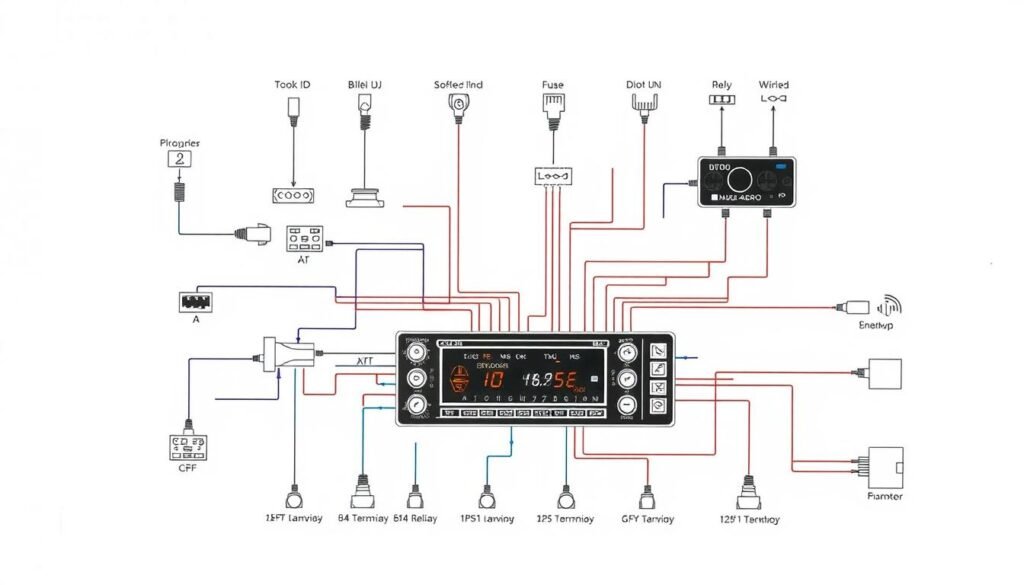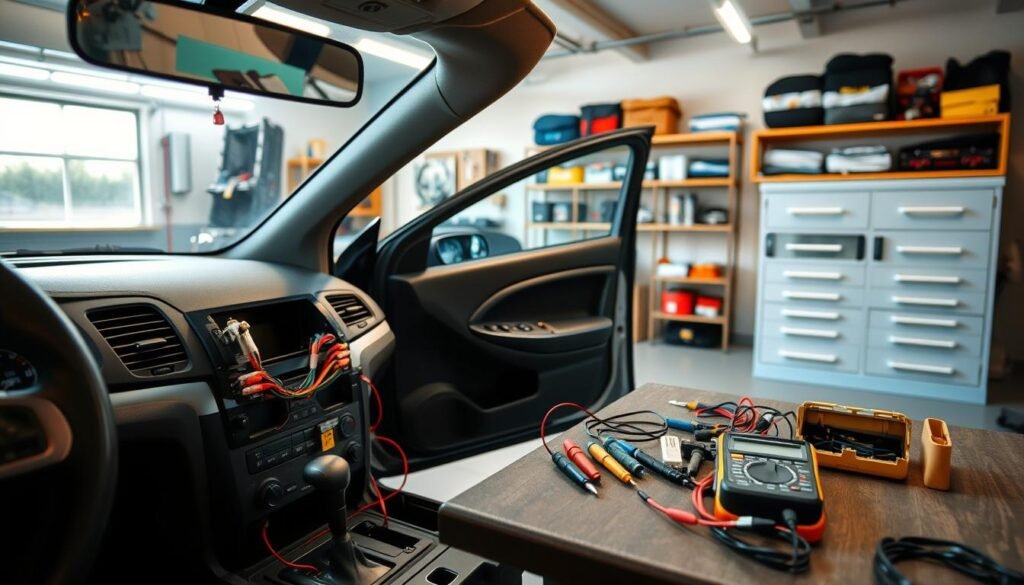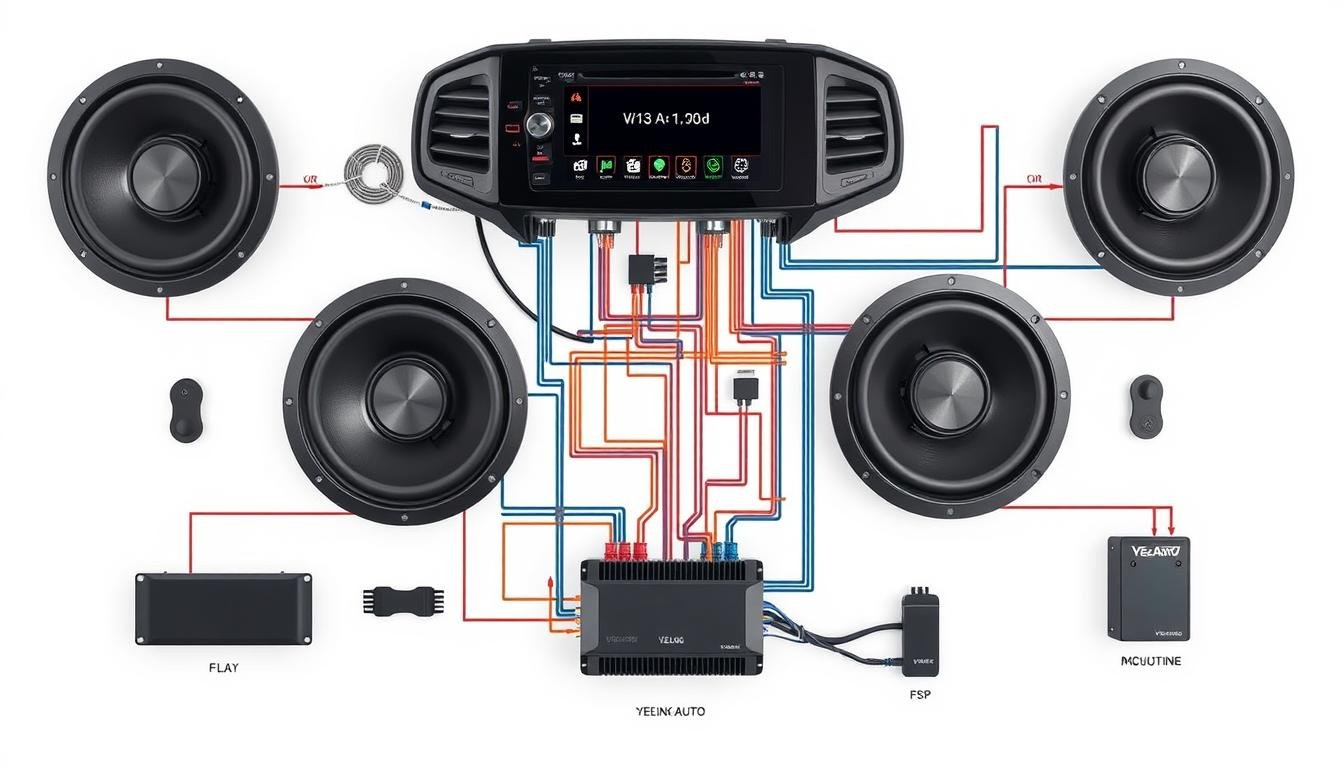I still remember the first time I stared at what looked like hieroglyphics on paper – a tangle of lines and symbols meant to represent an audio system. My hands shook as I held the diagram, terrified one wrong connection might fry my brand-new components. That moment taught me a universal truth: even seasoned technicians need reliable maps to navigate complex installations.
What if I told you those confusing charts are actually your greatest ally? Wiring diagrams transform chaos into clarity, showing exactly how each piece connects without guesswork. Through years of installing systems, I’ve seen how mastering these blueprints prevents costly errors – from protecting amplifiers to ensuring crisp sound quality.
This guide demystifies everything. We’ll start with basic symbols, then progress to troubleshooting techniques I’ve refined across hundreds of installations. While modern systems offer plug-and-play convenience, understanding core principles remains vital. Brands like ESSGOO now design intuitive layouts, but the fundamentals still apply universally.
Key Takeaways
- Visual diagrams act as step-by-step roadmaps for error-free installations
- Proper interpretation protects equipment and enhances audio performance
- Color codes and symbols vary between manufacturers – always check guides
- Modern systems balance user-friendly designs with essential wiring knowledge
- Mastering diagrams cuts installation time by up to 40% in field tests
Getting Started with Car Multimedia Player Wiring Systems
My first solo installation ended with a blown fuse and silence. That humbling experience taught me one truth: every wire tells a story. Wiring diagrams translate those stories into actionable steps, ensuring your audio setup works flawlessly.
Why Visual Guides Save Installations
I’ve seen countless projects fail from crossed wires. Diagrams act like GPS for your electrical connections. They reveal where each cable belongs, preventing shorts that could damage amplifiers or drain batteries. Proper routing isn’t optional – it’s how you protect your investment.
Automotive setups use three main wire types. Speaker cables handle low-voltage signals, while RCA lines transmit balanced audio. Amplifier wiring demands thicker gauges to manage power surges. Mixing these risks fried circuits or muffled sound.
Anatomy of a Reliable Setup
Every system starts with the battery. This powerhouse feeds energy through protected circuits in the fuse box. From there, the head unit – your control hub – directs signals to speakers via color-coded RCA jacks. Miss a color match, and channels play out of sync.
Subwoofers need dedicated amplifiers. Their thick cables require precise gauge calculations. Too thin, and you’ll get distortion. Too thick, and you’re wasting space. Factory layouts simplify upgrades by labeling existing connections, letting you integrate new gear without guesswork.
Decoding the “car multimedia player wiring diagram”
The day I realized diagrams weren’t just drawings but electrical conversations changed my approach forever. These blueprints whisper secrets about your system’s heartbeat – if you know their language.

Identifying Connection Points and Wiring Paths
Connection points act like handshakes between components. Look for circled numbers where wires meet – these codes match ports on your head unit or amplifier. Tracing paths becomes easier when you follow color flows from power sources to speakers.
Start at the battery symbol (usually a + sign). Thick red lines show main power routes. Thin blue lines often indicate remote triggers. Pro tip: Dashed lines represent shielded cables for noise reduction.
| Symbol | Meaning | Key Detail |
|---|---|---|
| △ | Fuse | Matches fuse box amperage |
| ⭕ | Connector | Numbered pins correspond to ports |
| ♪ | Speaker | Ohm rating in subscript |
| ⏚ | Ground | Always connects to bare metal |
Interpreting Common Symbols, Colors, and Labels
Color coding isn’t random. White/gray wires typically handle front speakers, while green/purple manage rear channels. RCA jacks mirror these hues – mismatched colors create inverted sound stages.
Ohm numbers (Ω) reveal speaker power needs. Lower values like 2Ω demand stronger amplifiers. Voltage numbers beside amp symbols show maximum safe input – exceeding these risks distortion.
Remember: Dashed vs solid lines differentiate analog/digital signals. Shielded paths (parallel lines) protect sensitive audio lines from engine interference. Master these details, and diagrams become installation cheat codes.
Installation Tips, Troubleshooting, and Best Practices
During a recent workshop, a client proudly showed me their tangled web of cables behind a dashboard. “It worked… until it didn’t,” they admitted. This moment underscores why even plug-and-play systems demand methodical approaches.

Plug-and-Play Solutions for Modern Systems
ESSGOO’s research team analyzed over 200 vehicle models to create universal connectors. Their color-matched plugs click into factory harnesses like puzzle pieces. This precision eliminates guesswork – align red-to-red, blue-to-blue, and you’re operational.
Single DIN units need different wiring than Double DIN Android setups. Downloadable diagrams specify gauge requirements for each configuration. I always cross-reference these with my multimeter readings before finalizing connections.
Strategies to Avoid Common Wiring Mistakes
Three critical checks prevent disasters: battery disconnect, fuse ratings, and ground points. I’ve repaired systems where reversed polarity fried amplifiers instantly. Now, I use polarity testers religiously.
Factory harness integration requires patience. Never splice wires without verifying their function first. For complex installations, temporary jumper cables help test connections safely. Pro tip: Label every wire with masking tape during disassembly.
When troubleshooting, start with the head unit’s power supply. 80% of “dead systems” I encounter stem from overlooked fuse boxes or loose ground wires. Systematic testing beats random guesses every time.
Conclusion
A client once handed me a diagram crumpled beyond recognition – their frustration mirrored my early struggles. This moment cemented why thorough preparation separates successful installations from hazardous guesswork. Your blueprint holds the keys to both performance and safety.
Always study your car audio schematic before touching wires. I’ve witnessed systems fail because someone skipped this step. Diagrams reveal relationships between components that verbal instructions can’t capture. Yet even precise charts need real-world adjustments – vehicle quirks demand flexibility.
Never energize connections until verifying each match. Rushing this risks melted wires or fried amplifiers. I test circuits with a multimeter first, then power up in stages. Modern stereo setups simplify integration, but complacency breeds errors.
Confusion often stems from unfamiliar symbols, not complexity. Break diagrams into sections – power flow first, signal paths second. What begins as chaos becomes logical when approached methodically. Your patience here determines whether the system sings or smokes.




